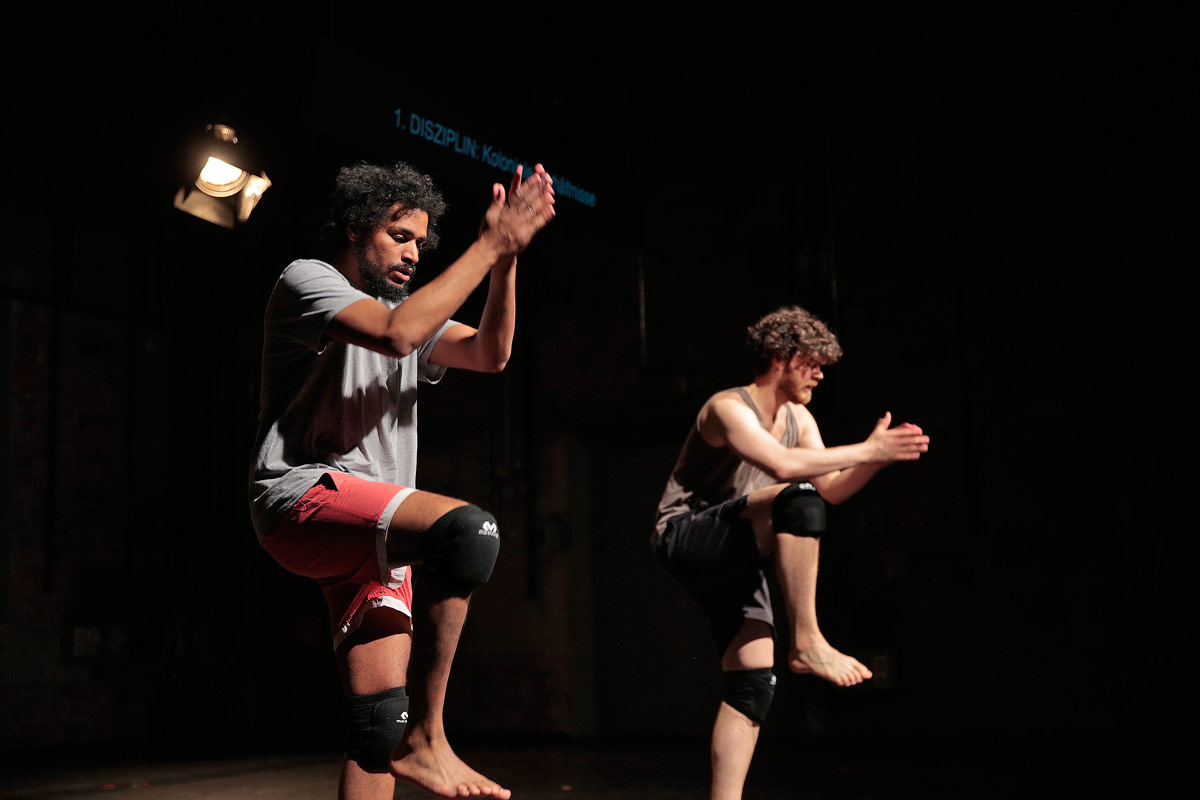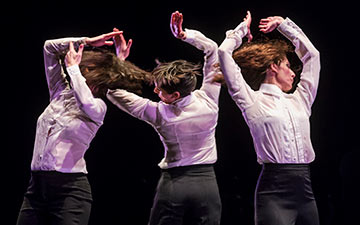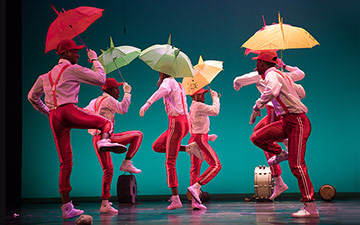
© Nicole Wytyczak. (Click image for larger version)
DanceTabs at the Royal Central School of Speech and Drama’s Collisions Festival 2018 – the annual festival that showcases their thriving Practice Research community.
A thoughtful report about thoughtful work that probes and presents how the dance of yesterday and today borrows and distorts the culture of others.
Hauptaktion at London’s Collisions Festival 2018
Situation With Doppelganger: Essay Performance
London, Royal Central School of Speech and Drama
26 September 2018
hauptaktion.de
www.cssd.ac.uk
Hauptaktion are a Munich-based dance and theatre company who embed research in their practice to create what they call performative essays. Their informative and highly physical performances embody archival research, cultural critique and movement seamlessly, while also being transparent about process, as they strip away theatrical embellishment. For Situation With Doppelganger: Essay Performance, Hauptaktion reflect on cultural appropriation and the 19th century American Minstrel shows.
Invited by research students from the Royal Central School of Speech and Drama to perform at their annual practice-as-research festival, COLLISIONS 2018, Hauptaktion’s multi-skilled Julian Warner & Oliver Zahn dance a gruelling line-up of black dance styles that have been appropriated and commercialised throughout European and American culture. They include Minstrel dances, pop, South African Gum-boot and folk dance. These dances and their reinventions through time are framed through the historical 1844 dance competition which took place in New York between two Minstrel stars, the black dancer (Master Juba) and white Irish dancer (John Diamond). The stakes were high for both as the white judges had to decide who was the best and most authentic dancer: the Afro-American Juba who was imitating whites imitating blacks, or the white Diamond as he impersonated blacks. By way of background, Minstrel shows were initially performed by white performers blacked up to parody Afro-Americans in crude, racial stereotypes. When black performers were finally allowed to perform in these shows, they did so as impersonators of their own race, in order to humour their mainly white audiences.
Warner and Zahn perform different historical ‘situations’ or scenes in which the various dance forms are demonstrated while a pre-recorded commentary by Tinka Kleffner discusses each dance from multiple perspectives: an elaborate account of each’s geographical setting, historical context, who the performers were, the actual movements or steps, critical reviews, responses from spectators and so on. What unfolds is a riveting tapestry of historiography, ethnography and social critique.

© Nicole Wytyczak. (Click image for larger version)
Zahn and Warner dance in unison embodying the folk dance styles of Bavaria which, as we’re informed, were danced by white Austrians wearing lederhosen for politicians attending the G7 Summit of 2015 in Krün. Their bodies are held erect, while quick, agile footwork punctuated by slapping the knees and ankles resembles the Gumboot Dance, which was performed by black dancers in South Africa for the King of Swaziland’s Birthday in 2013. However the military salutes and flexed torso which are characteristic of the Gumboot dance are both comparable and contrasting with the Bavarian folk dance as are the geographical settings of each event, vividly described by Kleffner’s voice.
Next, with dramatic black-outs and pauses indicating the end of each ‘situation’, Zahn and Warner reappear to demonstrate what is commonly known as twerking – thrusting pelvic gyrations performed in isolation to the rest of the body with backsides sticking out. Here Warner and Zahn enact the desiring, erotically charged humping actions with dead pan faces. As they continue to twerk harder, individually and together, Kleffner’s prosaic, German-accented voice draws our attention to an event happening in the black district of New Orleans, a scene in which trans, gay and lesbian members of the black community twerk erotically to music played by a DJ. From the pulsing beats of the New Orleans, we are briskly transported north to New York where Miley Cyrus twerks at the MTV awards accompanied by a backing chorus of black male dancers, and receives notoriety. It’s obvious why and Kleffner repeats that this movement like all the others mentioned “crossed the lines of decency for many”. However, as Kleffner’s smooth tones inform us, such criticism doesn’t deter a group of German women in Dortmund who sweat profusely as they learn twerking in a class for which they’ve paid good money.
While we are enlightened by Hauptaktion’s multi-dimensional, riveting documentary, our attention is drawn to the minimalistic presentation of both men’s bodies as they dance without music in the harsh spotlights, clothed in shorts and t-shirts. What’s fascinating is how they perform each dance style as if it was a perfunctory gym task: gaze detached but focussed on the audience, devoid of expression or bodily emotion. What we see instead is their perseverance to keep going, effort and exhaustion subtly detectable on their sweating bodies and in their occasional gasps for breath. It’s intensely powerful the affect produced by Warner’s brown body and Zahn’s white one as they energise their bodies, actively collaborating with the verbal text, playing out histories of race. The lighting and blackouts, operated by technician Dennis Kopp, provide necessary respites from the gruelling regime and also adds to the captivating intensity of the performance.

© Nicole Wytyczak. (Click image for larger version)
Following an interlude, where they borrow from Michael Jaskson’s ritualistic Zombie moves in Thriller, Zahn and Warner perform themes from Minstrelsy in the final sections. Here they re-enact the Cakewalk, a comical partner dance that black slaves on American plantations in 1859 danced to amuse their white masters, but were in reality mocking the foppish behaviour of these rich white ladies and gentlemen. The Cakewalk is notable for the leaning back position of the upper torso and the dancers’ faces which are fixed in a clownish grin.
As Warner and Zahn pivot round in a circle on one leg while tapping the other foot, their backs held straight, they recall a solo performed in 1833 by a white minstrel, nick-named Jim Crow, who with blacked up face imitated a disabled Afro American man, portraying the worse racial stereotyping. We imagine the visual setting, prompted by the voice-over, a seedy music hall in New York with a bawdy, drunken audience of white Irish, Germans and British people watching. Finally as the Zahn and Warner morph into a high- kicking, rigid-leg Irish jig, we hear about a nameless black dancer who was spotted in a shoddy, market district of NY around the same time performing something similar.
As we too feel the fatigue of these relentless, repetitive, high energy dances, the grim reality of what they represent becomes forcibly etched in our minds: the shocking revelations of cultural theft and racial stereotyping. As the complex layers of history and documentation are peeled back to hint at the origins of each dance, questions around ownership and who should be allowed to perform them become manifest. It’s an ingenious show and one that is just as important for its exposure of practice-based-research as the themes it carries.











You must be logged in to post a comment.